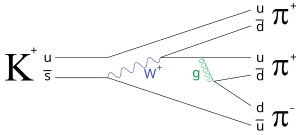Portal:Physics/Selected article/Week 44, 2006
A Feynman diagram is a method for performing calculations in quantum field theory, invented by American physicist Richard Feynman. They are also (rarely) referred to as Stückelberg diagrams or (for a subset of special cases) penguin diagrams. The lines represent particles interacting and mathematical terms correspond to each line and vertex (meeting of lines). The probability of a certain interaction happening is calculated by drawing the corresponding diagrams, and using them to derive the correct mathematical expressions. They are essentially a book-keeping tool with a simple visual physical interpretation of an event.

The interaction[disambiguation needed] between two particles is quantified by the cross section corresponding to their collision, essentially the probability of the interaction occurring. If the strength interaction is not too large, i.e. if it can be tackled via perturbation theory, this cross section (or more precisely the corresponding time evolution operator, propagator or S matrix) can be expressed as a sum of terms (the Dyson series) which can be described as a short story in time that sounds like the following:
- (once upon a time) two particles were moving freely with some relative speed (one draws two lines --edges -- going upwards),
- they met each other (the two lines meet at a first point -- vertex),
- took a stroll together on a common path (the lines merge in one vertical line)
- and, then separated again (second vertex)
- but they realized their speed had changed and they were not really the same anymore (two lines are drawn upwards coming from the last vertex -- sometimes in a different style to symbolize the change experienced by the particles).
This story can be drawn as a diagram which is generally easier to remember than the corresponding mathematical formula in the Dyson series. These diagrams are called Feynman diagrams. They are meaningful only if the Dyson series converges fast. Their easy story telling character and the similarity with the early bubble chamber experiments have made the Feynman diagrams very popular.
